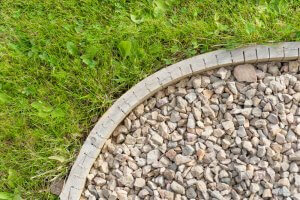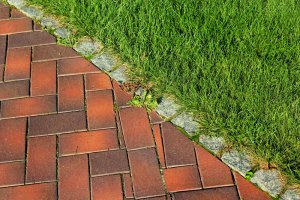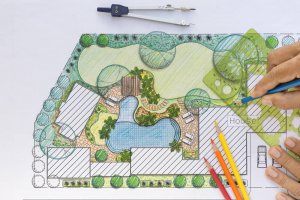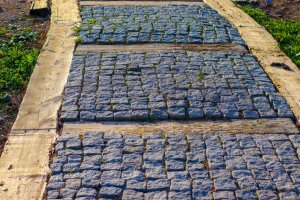Tips on How to Plan a Garden Path and Edging

Today, we’re going to give you some tips on how to plan a garden path and edging for your home. They’re both useful, decorative, and have very specific functions.
Functional edging
Although edging tends to be purely decorative, there are situations where it’s actually necessary. For example, if you want to enclose things like soil or gravel.
Edging always makes for a nice look in a garden. But outside of aesthetics, it stops the ground wearing down and prevents the soil from anything you’ve planted from spreading.
Some materials you can use for edging and garden paths

You can make edging in your garden out of tiles, stones, or bits of concrete. Wooden beams, pegs, and logs are also becoming more common as a material for edging and paths. They have a rustic, informal appearance that makes them look especially nice.
Layout and shape

There are lots of different ways to lay out your edging. The way you choose will also have an impact on the aesthetic. For example, you can place bricks in several different patterns: toothed, with diagonal cuts, or with round edges.
You can also put wooden pegs side by side in a diagonal pattern, which has a very interesting look. One cheap option involves using wire as your edging, which you would fix in place by nailing it into the ground.
Natural edging

Another great option is to make a natural edging with plants. If this sounds good to you, we recommend using short bushes, like boxwood and lavender, because they’re easy to trim. This type of edging goes really nicely beside a garden path.
Plan your garden path well
If you want to plan a garden path, always keep in mind that its basic function is to connect places, and act as a separator. You can also make it especially decorative by putting some kind of accessory, tree, or enclosure at the end of the path.
Along with giving you a path to walk along, they prevent the grass, borders, and plants from loosening and deteriorating. There are no standard measurements, but the thinnest it should be for one person to walk along it is 14 inches, and 30-40 for two.
Preliminary sketch

Before you start making your garden path, you need to plan it on paper. This will also help you calculate how much of each material you need.
You can also do some tests on the ground with tied-together string and small pegs or stakes. If you want a straight path, the string should be taut. If your path is curved, the strings should follow the curves.
Thinking of utility and aesthetics as you plan a garden path and/or edging

In many cases, you have to combine functional paths with others that are mostly aesthetic and act as decoration for the green spaces. The main paths, like the ones leading to the street or your garage, should be similar and not too long. You can design the secondary paths in other ways, though, if you want to.
A secondary path is basically anything that’s not necessary for you to get from one place to another. These are some of our favorite types:
- Japanese paths: these are very popular right now. The best materials for this are slate and sandstone. With this type of path, you leave space between each slab of stone.
- Sand path: these are generally best if you live in an area that doesn’t get much rain.
- Gravel paths: these are easy to maintain. You’ll also have to use weed killer though, to keep weeds from growing under them.
Choosing materials

Once you start picking out materials for your garden path, there are some things to keep in mind as you plan. This includes everything from the materials already in the area, the style of your home, how formal your garden is, your budget, all the way down to the characteristics of each material.
Outside of those considerations, the main thing to remember is that the materials for a garden path should always be practical, easy to maintain, and highly durable. You should also think about how they interact with water. You don’t want it to suck it all up, or trickle its way elsewhere.
There’s also a basic classification of materials here: soft and hard pavement. Hard pavement includes things like brick, slate, flagstones, marble, and granite. The most common forms of soft pavement are things like wood chips, mulch, or gravel.
Good plants to consider for your garden path plan

Crawling plants are great for the slots between each piece of a path. As you’re planting them, you do still need to keep in mind that they won’t grow as much in the areas you walk down a lot.
We would recommend avoiding any species that create thick shrubs that you might trip over. Some of the best plants to use for a garden path are things like daisies, chickweed, and candytuft.
Today, we’re going to give you some tips on how to plan a garden path and edging for your home. They’re both useful, decorative, and have very specific functions.
Functional edging
Although edging tends to be purely decorative, there are situations where it’s actually necessary. For example, if you want to enclose things like soil or gravel.
Edging always makes for a nice look in a garden. But outside of aesthetics, it stops the ground wearing down and prevents the soil from anything you’ve planted from spreading.
Some materials you can use for edging and garden paths

You can make edging in your garden out of tiles, stones, or bits of concrete. Wooden beams, pegs, and logs are also becoming more common as a material for edging and paths. They have a rustic, informal appearance that makes them look especially nice.
Layout and shape

There are lots of different ways to lay out your edging. The way you choose will also have an impact on the aesthetic. For example, you can place bricks in several different patterns: toothed, with diagonal cuts, or with round edges.
You can also put wooden pegs side by side in a diagonal pattern, which has a very interesting look. One cheap option involves using wire as your edging, which you would fix in place by nailing it into the ground.
Natural edging

Another great option is to make a natural edging with plants. If this sounds good to you, we recommend using short bushes, like boxwood and lavender, because they’re easy to trim. This type of edging goes really nicely beside a garden path.
Plan your garden path well
If you want to plan a garden path, always keep in mind that its basic function is to connect places, and act as a separator. You can also make it especially decorative by putting some kind of accessory, tree, or enclosure at the end of the path.
Along with giving you a path to walk along, they prevent the grass, borders, and plants from loosening and deteriorating. There are no standard measurements, but the thinnest it should be for one person to walk along it is 14 inches, and 30-40 for two.
Preliminary sketch

Before you start making your garden path, you need to plan it on paper. This will also help you calculate how much of each material you need.
You can also do some tests on the ground with tied-together string and small pegs or stakes. If you want a straight path, the string should be taut. If your path is curved, the strings should follow the curves.
Thinking of utility and aesthetics as you plan a garden path and/or edging

In many cases, you have to combine functional paths with others that are mostly aesthetic and act as decoration for the green spaces. The main paths, like the ones leading to the street or your garage, should be similar and not too long. You can design the secondary paths in other ways, though, if you want to.
A secondary path is basically anything that’s not necessary for you to get from one place to another. These are some of our favorite types:
- Japanese paths: these are very popular right now. The best materials for this are slate and sandstone. With this type of path, you leave space between each slab of stone.
- Sand path: these are generally best if you live in an area that doesn’t get much rain.
- Gravel paths: these are easy to maintain. You’ll also have to use weed killer though, to keep weeds from growing under them.
Choosing materials

Once you start picking out materials for your garden path, there are some things to keep in mind as you plan. This includes everything from the materials already in the area, the style of your home, how formal your garden is, your budget, all the way down to the characteristics of each material.
Outside of those considerations, the main thing to remember is that the materials for a garden path should always be practical, easy to maintain, and highly durable. You should also think about how they interact with water. You don’t want it to suck it all up, or trickle its way elsewhere.
There’s also a basic classification of materials here: soft and hard pavement. Hard pavement includes things like brick, slate, flagstones, marble, and granite. The most common forms of soft pavement are things like wood chips, mulch, or gravel.
Good plants to consider for your garden path plan

Crawling plants are great for the slots between each piece of a path. As you’re planting them, you do still need to keep in mind that they won’t grow as much in the areas you walk down a lot.
We would recommend avoiding any species that create thick shrubs that you might trip over. Some of the best plants to use for a garden path are things like daisies, chickweed, and candytuft.







